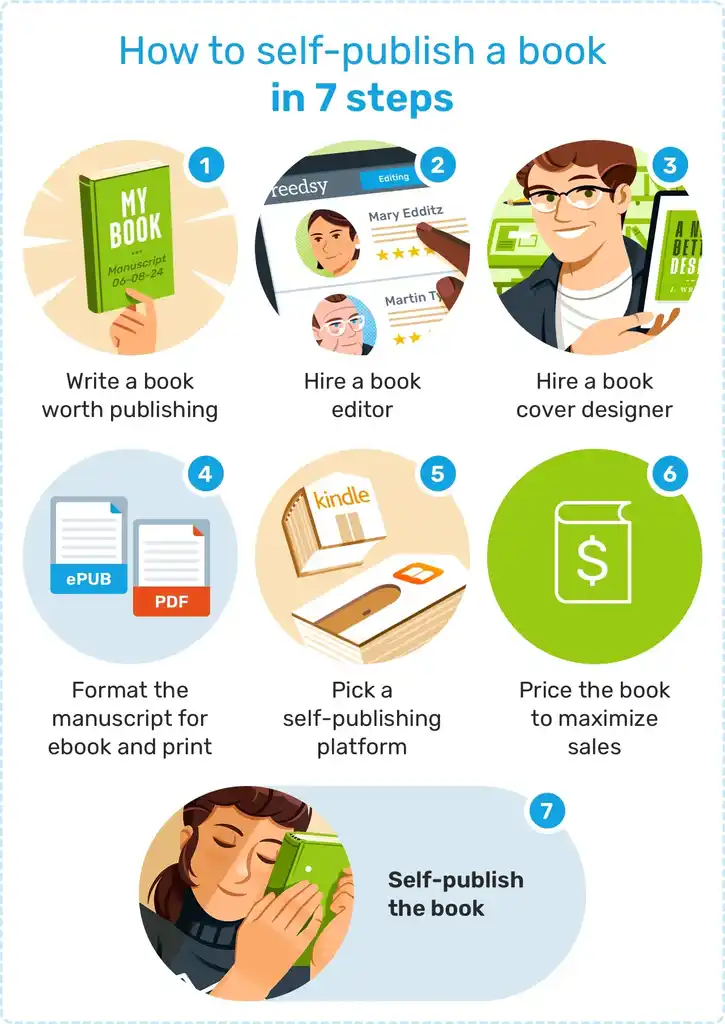Unlock the secrets to e-book publishing success with this comprehensive guide – your roadmap to digital literary fame awaits!

Image courtesy of Antoni Shkraba via Pexels
Table of Contents
- Introduction to E-Book Publishing
- Getting Started with Your E-Book
- Exploring E-Book Formats
- Designing Your E-Book
- Choosing the Right Publishing Platform
- Understanding Amazon’s Publishing Process
- Marketing Your E-Book
- Getting Reviews for Your E-Book
- Avoiding Common E-Book Publishing Mistakes
- Summary and Final Thoughts
- FAQs
Introduction to E-Book Publishing
Have you ever dreamed of becoming a published author and sharing your stories with the world? Thanks to e-book publishing, now you can do just that! E-book publishing is a fantastic way for budding writers like you to bring your creations to life without the need for traditional publishers. In this exciting guide, we’ll explore what e-book publishing is all about and why it’s a great avenue for aspiring authors.
What is E-Book Publishing?
So, what exactly is an e-book? An e-book, short for electronic book, is a digital version of a book that can be read on electronic devices like smartphones, tablets, or e-readers. Unlike traditional printed books, e-books can be easily accessed and downloaded online, making them a convenient and eco-friendly option for readers.
Reasons to Publish an E-Book
There are many reasons why authors might choose to publish their work in e-book format. One major advantage is the ease and speed of publishing – with e-book publishing platforms like Amazon Kindle Direct Publishing (KDP), authors can quickly make their books available to readers worldwide. Additionally, e-books are often more affordable for readers and offer a more interactive reading experience with features like adjustable font sizes and built-in dictionaries.
Getting Started with Your E-Book
So, you’ve got a story to share with the world and you’ve decided to dive into the exciting world of e-book publishing. Congratulations! Let’s walk through the steps to get you started on this amazing journey.
Writing Your Story
Every great e-book starts with a captivating story. Sit down with your favorite notebook or computer and let your imagination run wild. Think about what story you want to tell and let the words flow onto the page.
Preparing for Publication
Once you’ve finished writing your story, it’s time to prepare it for publication. Editing is crucial to make sure your story shines, so don’t be afraid to revise and polish your work. You’ll also need to think about cover design – a catchy cover can attract more readers to your e-book.
Remember, the key to a successful e-book is a well-written story and an appealing cover.
Exploring E-Book Formats
When it comes to publishing an e-book, one crucial decision authors must make is choosing the right file format. Each format has its own unique features and benefits, so it’s important to understand the differences before deciding how to publish your book.

Image courtesy of ebookfriendly.com via Google Images
Popular E-Book Formats
There are several common e-book formats available, but two of the most popular ones are PDF and ePub. Let’s take a closer look at each:
PDF: PDF stands for Portable Document Format, and it is widely used for e-books because of its compatibility across different devices and operating systems. PDF files maintain the original layout of the book, making them great for e-books with complex formatting, such as textbooks or picture books.
ePub: ePub is short for electronic publication, and it is a flexible format that adapts well to different screen sizes. ePub files are reflowable, which means the text adjusts to fit the screen, providing a seamless reading experience on various e-book readers and devices.
Choosing the right format for your e-book can make a significant impact on how readers engage with your content. Think about the type of book you’ve written and the reading experience you want to offer to determine which format is best suited for your publishing needs.
Designing Your E-Book
When it comes to creating an e-book, the design plays a crucial role in attracting readers and keeping them engaged. Here, we will explore the process of designing your e-book, focusing on simplicity and readability.
Cover Design
Your e-book’s cover is the first thing potential readers will see, so it needs to be eye-catching and representative of the content inside. Consider using vibrant colors, engaging images, and clear fonts to make your cover stand out. Remember, simplicity is key – don’t overload your cover with too much information.
Layout and Style
When it comes to the layout and style of your e-book, think about how to make it easy for readers to navigate and read. Choose a clean and simple layout that is visually appealing and allows for easy readability. Use headings, subheadings, bullet points, and images to break up the text and make it more digestible.
By focusing on creating a visually appealing cover and a clean, easy-to-read layout, you can design an e-book that will capture the attention of readers and keep them engaged from start to finish.
Choosing the Right Publishing Platform
When it comes to sharing your stories with the world through e-book publishing, choosing the right platform is crucial. Let’s explore what a publishing platform is and why it is an essential step for e-book authors.

Image courtesy of blog.reedsy.com via Google Images
What is Amazon KDP?
Amazon Kindle Direct Publishing, or Amazon KDP, is a platform that allows authors to self-publish their e-books on Amazon. It provides a straightforward process for authors to upload their books, set prices, and reach readers all around the globe. Amazon KDP is popular among authors for its ease of use and wide reach.
Other Publishing Platforms
Aside from Amazon KDP, there are other e-book publishing platforms available for authors to choose from. Some popular alternatives include Apple Books, Google Play Books, and Smashwords. Each platform has its own unique features and audience, so authors should explore their options and select the platform that best suits their needs and goals.
Understanding Amazon’s Publishing Process
Amazon Kindle Direct Publishing, also known as Amazon KDP, is a popular platform for authors to publish their e-books. If you’re wondering how to publish a book on Amazon, you’re in the right place. Let’s break down the process into simple steps that even a young reader can follow.
Account Setup
The first step to publishing your e-book on Amazon is creating an account on Amazon KDP. You will need to provide some basic information, such as your name, email address, and payment details. Once your account is set up, you’re ready to move on to the next step.
Uploading Your E-Book
After setting up your Amazon KDP account, it’s time to upload your e-book. You will need to format your book file according to Amazon’s guidelines and upload it to the platform. Make sure to double-check everything before hitting the publish button!
Setting the Right Price
Now comes the fun part – setting the price for your e-book. You can choose how much you want to sell your book for, keeping in mind factors like the length of the book, the genre, and what similar books are priced at. Remember, finding the right balance can attract more readers!
Marketing Your E-Book
After publishing your e-book, it’s essential to let the world know about it so that readers can discover and enjoy your story. Let’s explore some simple ways to market your e-book effectively!

Image courtesy of ebookfriendly.com via Google Images
Creating a Catchy Description
One of the first things potential readers will see is the book description. Make sure to write a captivating summary that entices readers to learn more about your e-book. Use exciting language to grab their attention and make them eager to dive into your story!
Using Social Media
Social media can be a powerful tool for spreading the word about your e-book. Share posts with your friends and followers, and ask them to help promote your book by sharing it with their networks. You can also join online book clubs or forums related to your genre to connect with more readers who might be interested in your work.
| Step | Action |
|---|---|
| 1 | Write a compelling and well-researched e-book |
| 2 | Design an eye-catching cover for your e-book |
| 3 | Format your e-book for different e-readers (Kindle, Nook, etc.) |
| 4 | Create a strong marketing plan for your e-book |
| 5 | Utilize social media and online platforms to promote your e-book |
| 6 | Engage with your readers and ask for reviews and feedback |
| 7 | Consider offering promotions or discounts to increase sales |
| 8 | Continuously update and improve your e-book based on feedback |
Getting Reviews for Your E-Book
Reviews are important because they help other readers decide whether your e-book is worth reading. Positive reviews can attract more people to check out your book and can also boost your credibility as an author. On the other hand, negative reviews can give you valuable feedback on how to improve your writing for future projects.
How to Get Reviews
If you want to get reviews for your e-book, it’s essential to ask your readers to share their thoughts honestly. You can reach out to friends, family members, or even fellow authors to read your book and leave a review. Additionally, you can encourage readers to leave reviews by including a request at the end of your e-book or on your author website.
Avoiding Common E-Book Publishing Mistakes
When it comes to publishing an e-book, there are some common mistakes that authors should try to avoid. By steering clear of these pitfalls, you can increase the chances of your e-book being successful and well-received by readers. Here are some simple tips to help you navigate the e-book publishing process smoothly.

Image courtesy of blog.kotobee.com via Google Images
Common Pitfalls
One common mistake that e-book authors make is rushing through the editing process. It’s crucial to take the time to carefully edit and proofread your e-book before publishing it. Typos, grammatical errors, and formatting issues can distract readers and detract from the overall quality of your work. Consider hiring a professional editor to help polish your manuscript and ensure it is error-free.
Another mistake to avoid is neglecting to create an eye-catching cover design. Your e-book cover is the first thing readers will see, and it plays a significant role in attracting potential buyers. Invest time and effort into designing a visually appealing cover that reflects the content of your book and entices readers to learn more.
Furthermore, pricing your e-book too high or too low can also be a misstep. Conduct research to determine a fair and competitive price for your e-book based on its genre, length, and target audience. Finding the right balance is key to maximizing sales and reaching a wider audience.
Learning from Others
One of the best ways to avoid common e-book publishing mistakes is to learn from the experiences of other authors. Join online writing communities, attend workshops or webinars, and seek advice from seasoned e-book authors. By listening to their insights and avoiding the pitfalls they encountered, you can enhance your own publishing journey and increase the likelihood of success.
Summary and Final Thoughts
Throughout this guide, we’ve explored the world of e-book publishing, discovering how budding authors can share their stories with the world. Let’s recap the key points we’ve covered.
What is E-Book Publishing?
E-book publishing is the process of creating digital books that readers can access on electronic devices like tablets, e-readers, or smartphones. Unlike traditional printed books, e-books can be easily distributed and accessed online.
Reasons to Publish an E-Book
Authors may choose to publish e-books for various reasons, including reaching a wider audience, reducing publishing costs, and having more control over the publishing process. E-books offer flexibility and accessibility that printed books may not provide.
Getting Started with Your E-Book
To begin your e-book publishing journey, start by writing your story and then consider aspects like editing, cover design, and formatting. Preparing your manuscript thoroughly is crucial for a successful e-book.
Exploring E-Book Formats
Understanding different e-book formats, such as PDF and ePub, is essential for choosing the right one for your book. Each format has its unique features and compatibility with various devices.
Designing Your E-Book
Designing an e-book involves creating an eye-catching cover and ensuring the layout and style of the pages are visually appealing and easy to read. Simplicity and readability are key factors in e-book design.
Choosing the Right Publishing Platform
Amazon KDP, or Amazon Kindle Direct Publishing, is a popular platform for e-book authors. It offers a user-friendly interface and a vast audience reach. Other publishing platforms also provide opportunities for authors to showcase their work.
Understanding Amazon’s Publishing Process
To publish your e-book on Amazon KDP, you need to set up an account, upload your book file, and decide on a selling price. Following these steps ensures your e-book is available to readers on one of the largest e-book platforms.
Marketing Your E-Book
Creating a compelling description and using social media are effective ways to promote your e-book and attract readers. Marketing plays a crucial role in making your e-book visible to potential readers.
Getting Reviews for Your E-Book
Reviews help establish credibility and encourage more readers to discover your e-book. Asking readers for honest feedback and actively seeking reviews can boost the visibility and popularity of your book.
Avoiding Common E-Book Publishing Mistakes
By being aware of common pitfalls and learning from the experiences of other authors, you can avoid mistakes that may hinder the success of your e-book. Taking proactive steps to improve your publishing process can lead to a more successful outcome.
In conclusion, e-book publishing offers a fantastic opportunity for aspiring authors to share their stories with a global audience. By following these guidelines and staying informed about the e-book publishing industry, you can embark on a successful e-book publishing journey.
FAQs
How long does it take to publish an e-book?
It can vary, but typically the time it takes to publish an e-book depends on the length of your story and how much time you dedicate to writing, editing, and formatting. On average, it could take a few weeks to a few months to complete the entire process.
Can I publish my e-book for free?
Yes, there are some e-book publishing platforms that allow you to publish your book for free, such as Amazon Kindle Direct Publishing (KDP). This means you can share your story with readers without any upfront costs.
What if I need help designing my e-book?
If you’re not confident in your design skills, you can always hire a professional designer to help you create a visually appealing e-book. Many freelance designers offer their services at reasonable rates and can assist you in making your e-book look polished and attractive.






